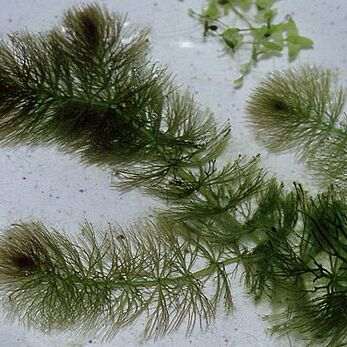Very similar to C. demersum in form, but usually more delicate and filamentous in appearance, differing as follows. Leaves usually lighter green, 2-4 cm long, branched dichotomously 3-4 times, sometimes one part of leaf branched more than another, rarely a few leaves of whorl only twice branched, usually rather fine, 0.1-0.3 mm in diameter, but lower 1-2 segments sometimes swollen and up to 2.5 mm across, marginal spiny teeth always minute, less than 0.1 or 0.2 mm, on lower 2 segments few or absent, few or more rarely numerous on final 2 segments. Male flowers up to 2 mm in diameter; mature anthers 0.6-0.8 mm long, 0.4-0.7 mm wide (length 1-1.5 times width). Female perianth-segments usually longer, (1.5-)1.8-2 mm long, 0.1-0.3 mm wide, and relatively narrower (length (5-)7-10 times width). Mature fruit with apical spine less than 1 up to 9 mm; surface sometimes with few large warts or spines.
Aquatic herb similar to Ceratophyllum demersum, but usually more delicate, differing as follows: Leaves usually lighter green, 2–4 cm. long, branching dichotomously 3–4 times (rarely twice in some whorls), usually rather fine, 0.1–0.3 mm. thick, to 2.5 mm. thick in lower segments, marginal teeth few, inconspicuous, often absent from lower segments, up to 0.1–0.2 mm. long.
Much like C. demersum, up to 1 m long, leaves in whorls of 6-8, adult ones 1¾- long, bright green. Flowers not yet found in Malaysia. ♀: ripe fruit black, ± 4 mm long, only the style thickened into an apical soft spine, basal spines absent.
Male flowers to 2 mm. in diam.; anthers 0.6–0.8 x 0.4–0.7 mm., often smaller and relatively broader than in C. demersum.
Female perianth lobes (1.5) 1.8–2 x 0.1–0.3 mm., relatively narrower and usually longer than in C. demersum.
Fruit usually markedly laterally flattened with a marginal rim or wing.


